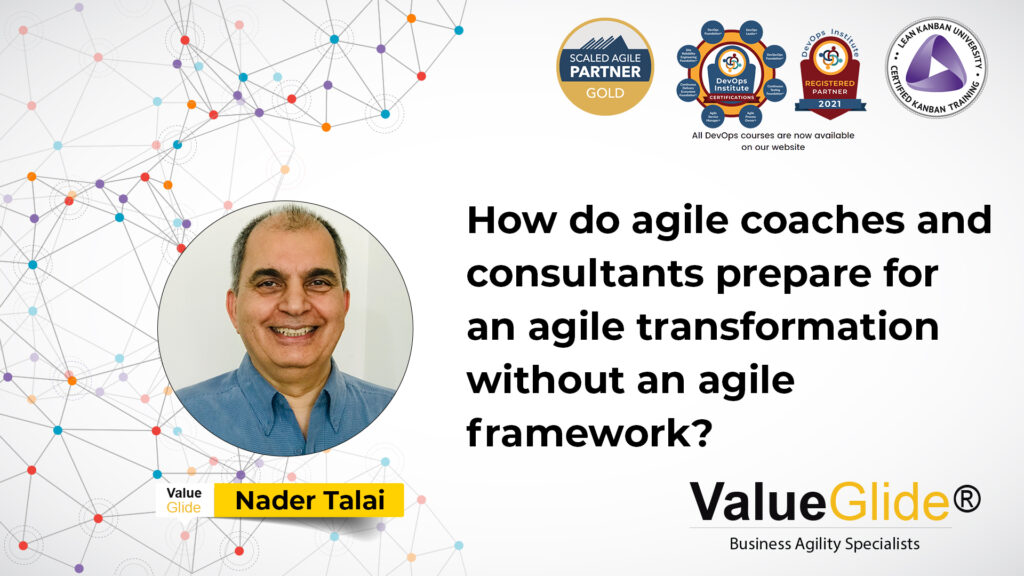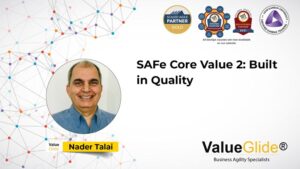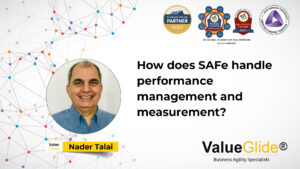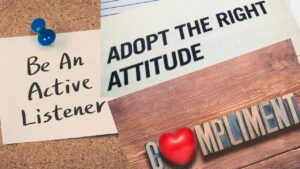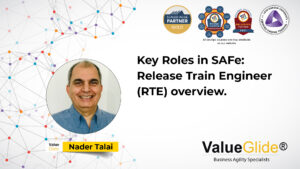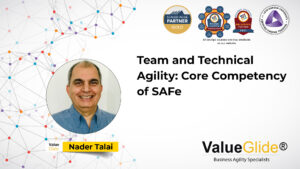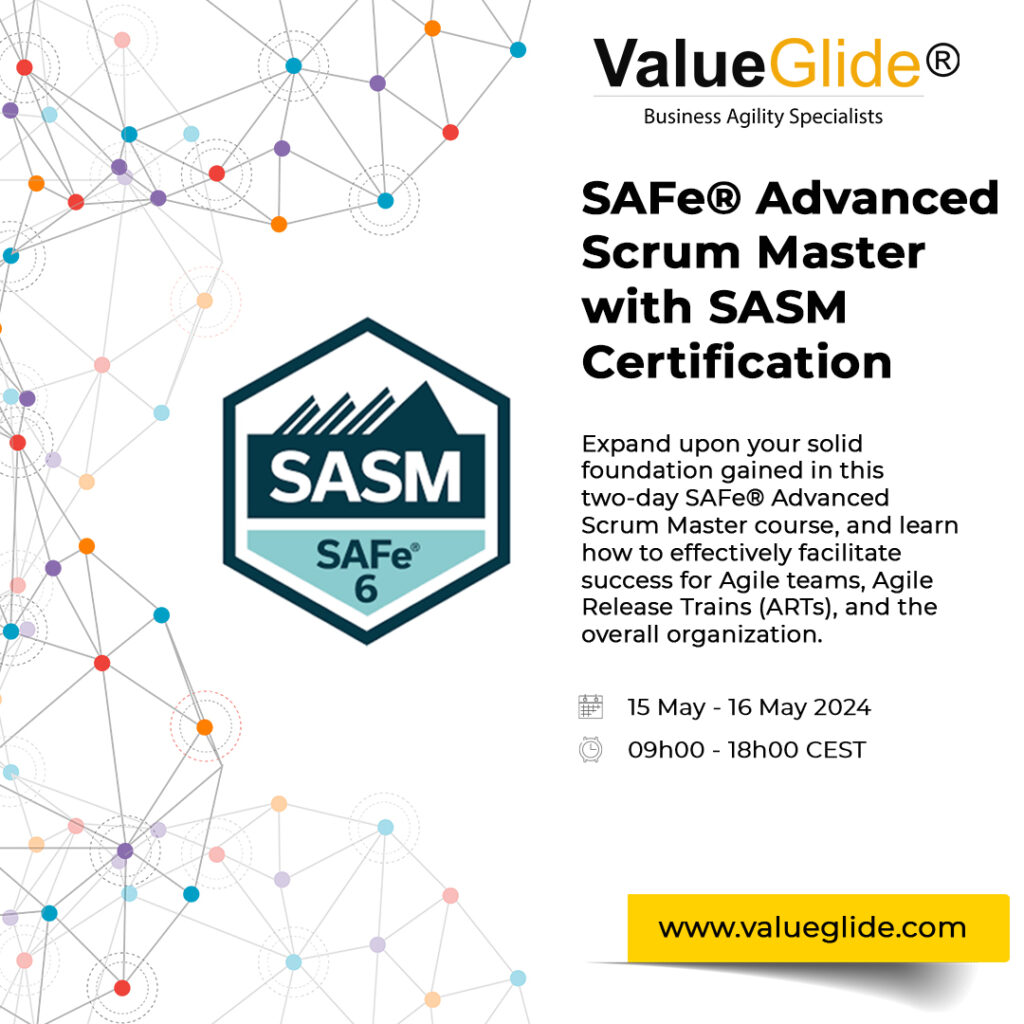How do agile coaches and consultants prepare for an agile transformation without an agile framework?
At Value Glide, we never enter a client engagement with a particular solution in mind.
A process of discovery
We always start with a process of discovery to understand the client environment.
- What are the optimization goals our client has in mind?
- What is the purpose of the agile transformation?
- How do we aim to serve our client’s clients more effectively?
- What are the most important organizational goals and objectives?
And so forth.
Form follows function.
We are fortunate to work with multiple agile frameworks, SAFe or Scaled Agile Framework is only one of the options available to us, and so we first need to understand the client environment as well as the environments our client serves.
Many agile coaches will view a problem through the lens of a predetermined solution, and it makes it incredibly tough to design a great solution. If the only tool you have in your toolbox is a hammer, you tend to view everything around you as a nail.
Identify the measures that inform success.
Our next step is to identify the measures and metrics that indicate whether we are succeeding in achieving our client’s goals and objectives, and whether we are moving the needle on the elements that most matter to their clients.
Things like:
- Time to market metrics
- Customer satisfaction metrics
- Revenue stream metrics
- Operational cost reduction metrics
And so forth.
Being clear about what we are measuring, and how we are measuring progress, enables us to quickly identify that what we are doing is working, and focus on improving with each iteration. It also allows us to quickly identify where we are failing, and rapidly pivot to meet the agreed goals and objectives.
Determine where the organization is currently at.
We’ve identified what is needed, and we have identified where we are going, and now we determine where we currently are as a baseline benchmark of performance.
We also use the current state analysis to inform what is possible and what tools or frameworks might best serve in helping us move forward and gain momentum. Based on what we know,
- Which Agile framework best suits our current capability and will help us move forward?
- What are the processes and practices that will help us increase agile capability?
- What are the first steps needed to build momentum and start learning?
And so forth.
It is a process of co-selection in that we work closely with customers to identify what is best suited to their environment, works within their current constraints, and will allow them to move the needle on the metrics that matter.
So, the method comes last.
We first need to understand the context, the objectives, and the current capability before we consider potential solutions and frameworks.
Commence with the engagement.
This is where the rubber meets the road.
At this point, our agile trainers, agile coaches, and agile consultants begin to work with the client to set everything in motion.
Often this will start with training key personnel on key elements. If they have selected scrum, we’ll do scrum training. If it’s Kanban, we’ll work on developing skills and capabilities in that area. If it’s SAFe, we’ll identify which roles and responsibilities require specific training and get people aboard certification programs that align with their key function and contribution.
As we begin the first series of sprints, we’ll be designing the specific interventions that are necessary from agile coaches and consultants. We’ve identified specific problems, challenges, and constraints within the current environment and now we set about resolving them.
In many ways, this is a process of co-creation.
Sure, our consultants and coaches are leading the way because your team have never worked in this way before, but we are imparting knowledge, skills, and developing capabilities through the process that empowers your team to excel in the future.
Our goal is always to exit at some point down the line when the team have the necessary competence and capability to press forward and evolve with each iteration, and so all coaching and consulting efforts are directed toward growing that internal agile capability.
A culture of experimentation and learning
The interventions that we make, in conjunction with our client’s teams, are hypothesis driven.
Based on what we currently know, and in alignment with a specific outcome or objective we want to achieve, what would be the most effective experiment we could run to prove or disprove the hypothesis.
In complex environments, we simply don’t know certain things upfront and so we must navigate that uncertainty and complexity through a series of cheap, rapid experiments that empower us to learn and evolve through the data and evidence we gather in the process.
As we develop this culture of learning and innovation, our client’s teams begin to develop their agile capability by using their domain expertise to inform what the next most valuable step will be. What they learn through that process will inform what happens after that. And so forth.
Once the agile release train, or team of agile teams, are effectively executing and innovating in alignment with customer and organizational objectives, it is time for our team to step away and begin to work with other agile release trains on other customer and organizational objectives.
We repeat the process from scratch because there is no copy and paste approach to achieving agility. Each team, customer, and organizational department is different and requires it’s own unique, custom-designed approach.
And that, in a nutshell, is how Value Glide coaches and consultants prepare for an agile transformation without a specific agile framework in mind.
About Value Glide
Value Glide are a SAFe (Scaled Agile Framework) consultancy, coaching practice, and training specialist who work with organizations to align business objectives with customer needs and wants.
As deeply experienced agile coaches and practitioners, our team are invested in continuous learning through each client engagement and use the data and evidence we gather from each implementation to inform our training, coaching, and consulting services.
In a nutshell, empirical process control or empiricism.
If you are thinking of adopting agile within your organization and have identified SAFe as a great agile framework to adopt, implement and improve your business agility, visit our SAFe Quickstart ART Launch program page or view our SAFe Consulting Services page.
If you have identified a need for an agile coach and SAFe coach to help your organization adopt and implement SAFe, visit our SAFe Coaching Services page.
If you want to know more about SAFe and how to lead SAFe, visit our SAFE Training page for a host of options, from Leading SAFe to a SAFe Release Train Engineer course.
#SAFe #scaledagileframework #scalingagile #agile #agileframework #agilecoach

